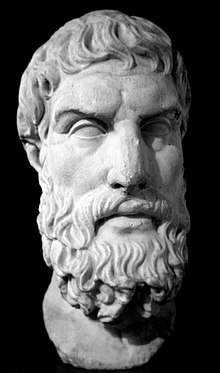https://en.wikipedia.org/wiki/Psychological_egoism
Psychological egoism is the view that humans are always motivated by self-interest and selfishness, even in what seem to be acts of altruism. It claims that, when people choose to help others, they do so ultimately because of the personal benefits that they themselves expect to obtain, directly or indirectly, from so doing. This is a descriptive rather than normative view, since it only makes claims about how things are, not how they ought to be. It is, however, related to several other normative forms of egoism, such as ethical egoism and rational egoism.
A specific form of psychological egoism is psychological hedonism, the view that the ultimate motive for all voluntary human action is the desire to experience pleasure or to avoid pain. Many discussions of psychological egoism focus on this type, but the two are not the same: theorists have explained behavior motivated by self-interest without using pleasure and pain as the final causes of behavior. Psychological hedonism argues actions are caused by both a need for pleasure immediately and in the future. However, immediate gratification can be sacrificed for a chance of greater, future pleasure. Further, humans are not motivated to strictly avoid pain and only pursue pleasure, but, instead, humans will endure pain to achieve the greatest net pleasure. Accordingly, all actions are tools for increasing pleasure or decreasing pain, even those defined as altruistic and those that do not cause an immediate change in satisfaction levels.
Psychological egoism is the view that humans are always motivated by self-interest and selfishness, even in what seem to be acts of altruism. It claims that, when people choose to help others, they do so ultimately because of the personal benefits that they themselves expect to obtain, directly or indirectly, from so doing. This is a descriptive rather than normative view, since it only makes claims about how things are, not how they ought to be. It is, however, related to several other normative forms of egoism, such as ethical egoism and rational egoism.
A specific form of psychological egoism is psychological hedonism, the view that the ultimate motive for all voluntary human action is the desire to experience pleasure or to avoid pain. Many discussions of psychological egoism focus on this type, but the two are not the same: theorists have explained behavior motivated by self-interest without using pleasure and pain as the final causes of behavior. Psychological hedonism argues actions are caused by both a need for pleasure immediately and in the future. However, immediate gratification can be sacrificed for a chance of greater, future pleasure. Further, humans are not motivated to strictly avoid pain and only pursue pleasure, but, instead, humans will endure pain to achieve the greatest net pleasure. Accordingly, all actions are tools for increasing pleasure or decreasing pain, even those defined as altruistic and those that do not cause an immediate change in satisfaction levels.
Foundations
Beginning with ancient philosophy, Epicureanism claims humans live to maximize pleasure. Epicurus
argued the theory of human behavior being motivated by pleasure alone
is evidenced from infancy to adulthood. Humanity performs altruistic,
honorable, and virtuous acts not for the sake of another or because of a
moral code but rather to increase the well being of the self.
In modern philosophy, Jeremy Bentham asserted, like Epicurus, that human behavior is governed by a need to increase pleasure and decrease pain.
Bentham explicitly described what types and qualities of pain and
pleasure exist, and how human motives are singularly explained using
psychological hedonism. Bentham attempted to quantify psychological
hedonism. Bentham endeavored to find the ideal human behavior based on hedonic calculus
or the measurement of relative gains and losses in pain and pleasure to
determine the most pleasurable action a human could choose in a
situation.
From an evolutionary perspective, Herbert Spencer,
a psychological egoist, argued that all animals primarily seek to
survive and protect their lineage. Essentially, the need for the
individual and for the individual's immediate family to live supersedes
the others' need to live.
All species attempt to maximize their own chances of survival and,
therefore, well being. Spencer asserted the best adapted creatures will
have their pleasure levels outweigh their pain levels in their
environments. Thus, pleasure meant an animal was fulfilling its egoist
goal of self survival, and pleasure would always be pursued because
species constantly strive for survival.
Contributions to modern psychology
Psychoanalysis
Whether or not Sigmund Freud was a psychological egoist, his concept of the pleasure principle borrowed much from psychological egoism and psychological hedonism in particular. The pleasure principle rules the behavior of the Id which is an unconscious force driving humans to release tension from unfulfilled desires. When Freud introduced Thanatos and its opposing force, Eros,
the pleasure principle emanating from psychological hedonism became
aligned with the Eros, which drives a person to satiate sexual and
reproductive desires.
Alternatively, Thanatos seeks the cessation of pain through death and
the end of the pursuit of pleasure: thus a hedonism rules Thanatos, but
it centers on the complete avoidance of pain rather than psychological
hedonist function which pursues pleasure and avoids pain. Therefore,
Freud believed in qualitatively different hedonisms where the total
avoidance of pain hedonism and the achievement of the greatest net
pleasure hedonism are separate and associated with distinct functions
and drives of the human psyche.
Although Eros and Thanatos are ruled by qualitatively different types
of hedonism, Eros remains under the rule of Jeremy Bentham's quantitative psychological hedonism because Eros seeks the greatest net pleasure.
Behaviorism
Traditional behaviorism dictates all human behavior is explained by classical conditioning and operant conditioning. Operant conditioning works through reinforcement and punishment
which adds or removes pleasure and pain to manipulate behavior. Using
pleasure and pain to control behavior means behaviorists assumed the
principles of psychological hedonism could be applied to predicting
human behavior. For example, Thorndike's law of effect states that behaviors associated with pleasantness will be learned and those associated with pain will be extinguished.
Often, behaviorist experiments using humans and animals are built
around the assumption that subjects will pursue pleasure and avoid pain.
Although psychological hedonism is incorporated into the fundamental
principles and experimental designs of behaviorism, behaviorism itself
explains and interprets only observable behavior and therefore does not
theorize about the ultimate cause of human behavior. Thus, behaviorism
uses but does not strictly support psychological hedonism over other
understandings of the ultimate drive of human behavior.
Debate
Psychological
egoism is controversial. Proponents cite evidence from introspection:
reflection on one's own actions may reveal their motives and intended
results to be based on self-interest. Psychological egoists and
hedonists have found through numerous observations of natural human
behavior that behavior can be manipulated through reward and punishment
both of which have direct effects of pain and pleasure. Also, the work of some social scientists has empirically supported this theory. Further, they claim psychological egoism posits a theory that is a more parsimonious explanation than competing theories.
Opponents have argued that psychological egoism is not more
parsimonious than other theories. For example, a theory that claims
altruism occurs for the sake of altruism explains altruism with less
complexity than the egoistic approach. The psychological egoist asserts
humans act altruistically for selfish reasons even when cost of the
altruistic action is far outweighed by the reward of acting selfishly
because altruism is performed to fulfill the desire of a person to act
altruistically. Other critics argue that it is false either because it is an over-simplified interpretation of behavior or that there exists empirical evidence of altruistic behaviour. Recently, some have argued that evolutionary theory provides evidence against it.
Critics have stated that proponents of psychological egoism often
confuse the satisfaction of their own desires with the satisfaction of
their own self-regarding desires. Even though it is true that
every human being seeks his own satisfaction, this sometimes may only be
achieved via the well-being of his neighbor. An example of this
situation could be phoning for an ambulance when a car accident has
happened. In this case, the caller desires the well-being of the victim,
even though the desire itself is the caller's own.
To counter this critique, psychological egoism asserts that all
such desires for the well being of others are ultimately derived from
self-interest. For example, German philosopher Friedrich Nietzsche was a psychological egoist for some of his career, though he is said to have repudiated that later in his campaign against morality. He argues in §133 of The Dawn,
that in such cases compassionate impulses arise out of the projection
of our identity unto the object of our feeling. He gives some
hypothetical examples as illustrations to his thesis: that of a person,
feeling horrified after witnessing a personal feud, coughing blood, or
that of the impulse felt to save a person who is drowning in the water.
In such cases, according to Nietzsche, there comes into play unconscious
fears regarding our own safety. The suffering of another person is felt
as a threat to our own happiness and sense of safety, because it
reveals our own vulnerability to misfortunes, and thus, by relieving it,
one could also ameliorate those personal sentiments. Essentially,
proponents argue that altruism is rooted in self-interest whereas
opponents claim altruism occurs for altruism's sake or is caused by a
non-selfish reason.
Problem of apparent altruism
David
Hume once wrote, "What interest can a fond mother have in view, who
loses her health by assiduous attendance on her sick child, and
afterwards languishes and dies of grief, when freed, by its death [the
child's], from the slavery of that attendance?". It seems incorrect to describe such a mother's goal as self-interested.
Psychological egoists, however, respond that helping others in
such ways is ultimately motivated by some form of self-interest, such as
non-sensory satisfaction, the expectation of reciprocation, the desire
to gain respect or reputation, or by the expectation of a reward in a
putative afterlife. The helpful action is merely instrumental to these
ultimately selfish goals.
In the ninth century, Mohammed Ibn Al-Jahm Al-Barmaki (محمد بن الجـَهْم البَرمَكي) has been quoted saying:
"No one deserves thanks from another about something he has done for him or goodness he has done, he is either willing to get a reward from God, therefore he wanted to serve himself, or he wanted to get a reward from people, therefore, he has done that to get profit for himself, or to be mentioned and praised by people, therefore, to it is also for himself, or due to his mercy and tenderheartedness, so he has simply done that goodness to pacify these feelings and treat himself."
This sort of explanation appears to be close to the view of La Rochefoucauld (and perhaps Hobbes).
According to psychological hedonism, the ultimate egoistic motive
is to gain good feelings of pleasure and avoid bad feelings of pain.
Other, less restricted forms of psychological egoism may allow the
ultimate goal of a person to include such things as avoiding punishments
from oneself or others (such as guilt or shame) and attaining rewards
(such as pride, self-worth, power or reciprocal beneficial action).
Some psychologists explain empathy
in terms of psychological hedonism. According to the "merge with others
hypothesis", empathy increases the more an individual feels like they
are one with another person, and decreases as the oneness decreases.
Therefore, altruistic actions emanating from empathy and empathy itself
are caused by making others' interests our own, and the satisfaction of
their desires becomes our own, not just theirs. Both cognitive studies and neuropsychological
experiments have provided evidence for this theory: as humans increase
our oneness with others our empathy increases, and as empathy increases
our inclination to act altruistically increases. Neuropsychological studies have linked mirror neurons
to humans experiencing empathy. Mirror neurons are activated both when
a human (or animal) performs an action and when they observe another
human (or animal) performs the same action. Researchers have found that
the more these mirror neurons fire the more human subjects report
empathy. From a neurological perspective, scientists argue that when a
human empathizes with another, the brain operates as if the human is
actually participating in the actions of the other person. Thus, when
performing altruistic actions motivated by empathy, humans experience
someone else's pleasure of being helped. Therefore, in performing acts
of altruism, people act in their own self interests even at a
neurological level.
Criticism
Explanatory power
Even
accepting the theory of universal positivity, it is difficult to
explain, for example, the actions of a soldier who sacrifices his life
by jumping on a grenade in order to save his comrades. In this case,
there is simply no time to experience positivity toward one's actions,
although a psychological egoist may argue that the soldier experiences
moral positivity in knowing that he is sacrificing his life to ensure
the survival of his comrades, or that he is avoiding negativity
associated with the thought of all his comrades dying.
Psychological egoists argue that although some actions may not clearly
cause physical nor social positivity, nor avoid negativity, one's
current contemplation or reactionary mental expectation of these is the
main factor of the decision. When a dog is first taught to sit, it is
given a biscuit. This is repeated until, finally, the dog sits without
requiring a biscuit. Psychological egoists could claim that such
actions which do not 'directly' result in positivity, or reward, are not
dissimilar from the actions of the dog. In this case, the action
(sitting on command) will have become a force of habit, and breaking
such a habit would result in mental discomfort. This basic theory of
conditioning behaviour, applied to other seemingly ineffective positive
actions, can be used to explain moral responses that are instantaneous
and instinctive such as the soldier jumping on the grenade.
Circularity
Psychological egoism has been accused of being circular:
"If a person willingly performs an act, that means he derives personal
enjoyment from it; therefore, people only perform acts that give them
personal enjoyment." In particular, seemingly altruistic acts must be
performed because people derive enjoyment from them and are therefore,
in reality, egoistic. This statement is circular because its conclusion
is identical to its hypothesis: it assumes that people only perform
acts that give them personal enjoyment, and concludes that people only
perform acts that give them personal enjoyment. This objection was
tendered by William Hazlitt and Thomas Macaulay in the 19th century, and has been restated many times since. An earlier version of the same objection was made by Joseph Butler in 1726.
Joel Feinberg, in his 1958 paper "Psychological Egoism", embraces a similar critique by drawing attention to the infinite regress of psychological egoism. He expounds it in the following cross-examination:
- "All men desire only satisfaction."
- "Satisfaction of what?"
- "Satisfaction of their desires."
- "Their desires for what?"
- "Their desires for satisfaction."
- "Satisfaction of what?"
- "Their desires."
- "For what?"
- "For satisfaction"—etc., ad infinitum.
Evolutionary argument
In their 1998 book, Unto Others, Sober and Wilson detailed an evolutionary argument based on the likelihood for egoism to evolve under the pressures of natural selection.
Specifically, they focus on the human behavior of parental care. To set
up their argument, they propose two potential psychological mechanisms
for this. The hedonistic mechanism is based on a parent's ultimate
desire for pleasure or the avoidance of pain and a belief that caring
for its offspring will be instrumental to that. The altruistic mechanism
is based on an altruistic ultimate desire to care for its offspring.
Sober and Wilson argue that when evaluating the likelihood of a
given trait to evolve, three factors must be considered: availability,
reliability and energetic efficiency. The genes for a given trait must
first be available in the gene pool for selection. The trait must then reliably produce an increase in fitness for the organism. The trait must also operate with energetic efficiency
to not limit the fitness of the organism. Sober and Wilson argue that
there is neither reason to suppose that an altruistic mechanism should
be any less available than a hedonistic one nor reason to suppose that
the content of thoughts and desires (hedonistic vs. altruistic) should
impact energetic efficiency. As availability and energetic efficiency
are taken to be equivalent for both mechanisms it follows that the more
reliable mechanism will then be the more likely mechanism.
For the hedonistic mechanism to produce the behavior of caring
for offspring, the parent must believe that the caring behavior will
produce pleasure or avoidance of pain for the parent. Sober and Wilson
argue that the belief also must be true and constantly reinforced, or it
would not be likely enough to persist. If the belief fails then the
behavior is not produced. The altruistic mechanism does not rely on
belief; therefore, they argue that it would be less likely to fail than
the alternative, i.e. more reliable




